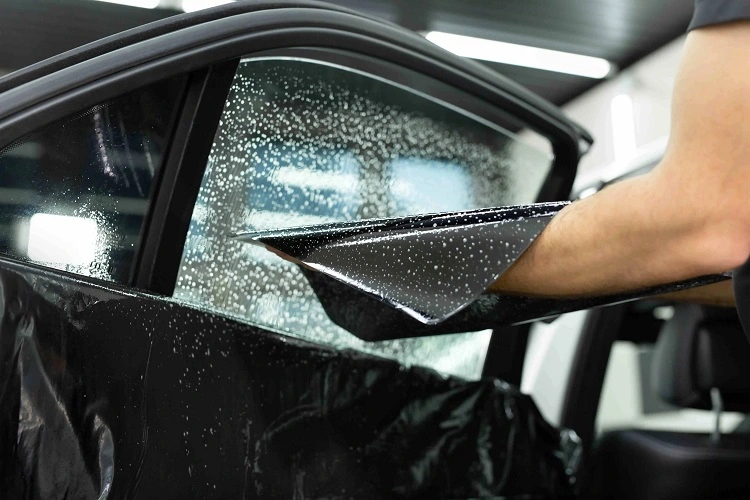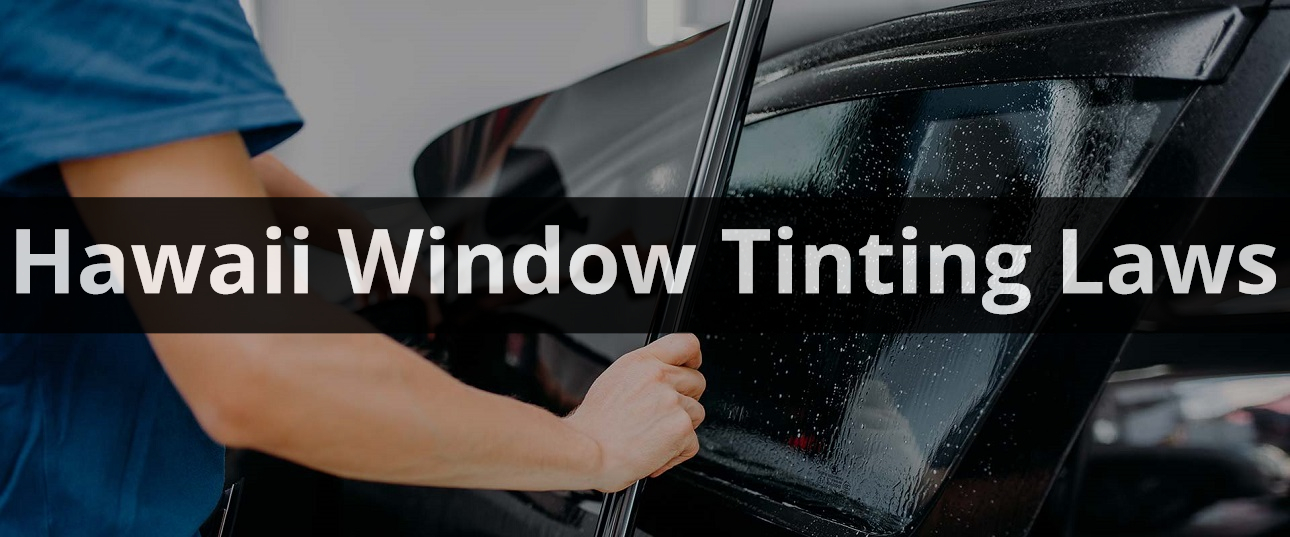Darkest legal tint for Sedans in Hawaii
- Windshield: The darkest legal tint allowed for the windshield is 35% for Sedans.
- Front Side windows: The darkest legal tint allowed is 35%
- Back Side windows: The darkest legal tint allowed is 35%
- Rear window: The darkest legal tint allowed is 35%
Darkest legal tint for SUV and Vans in Hawaii
- Windshield: The darkest legal tint allowed for the windshield is 35% for Sedans.
- Front Side windows: The darkest legal tint allowed is 35%
- Back Side windows: The darkest legal tint allowed is 35%
- Rear window: The darkest legal tint allowed is 35%
Hawaii Tinting Regulations

Hey there, sunshine seekers! If you’re planning to hit the roads in Hawaii with your stylish tinted windows, you might want to buckle up and read this guide. Hawaii, the land of surf, sand, and sunshine, is indeed a paradise. However, even in this tropical haven, there are rules to follow when it comes to tinting your vehicle windows.
Let’s Talk Numbers: Visible Light Transmission (VLT)
In Hawaii, tinted windows are all about striking a balance between style and safety. The regulations for vehicle window tinting are primarily based on Visible Light Transmission (VLT) percentage. VLT refers to the amount of visible light that can pass through your car’s windows. The lower the VLT percentage, the darker the tint.
Front Side Windows: 35% VLT
When it comes to your front side windows, Hawaii mandates a minimum of 35% VLT. This means that at least 35% of visible light must be able to pass through your front side windows. It’s a safety measure to ensure that drivers have clear visibility, especially during those breathtaking Hawaiian sunsets.
Back Side Windows and Rear Window: No Limit
Unlike the front side windows, Hawaii does not impose specific VLT limits on the back side windows and the rear window. This means you have more flexibility in tinting these windows, allowing you to find the perfect balance between style and comfort.
Side Mirrors: Required for Dark Tints
Here’s a heads-up: if you decide to go for a darker tint on your back side windows and rear window, Hawaii law requires you to have both side mirrors on your vehicle. This regulation enhances safety by ensuring that even with a darker tint, you have adequate visibility, especially when changing lanes.
Windshield Tinting: Top 4 Inches Only
Now, let’s talk windshields. While you might want to shield yourself from the intense Hawaiian sun, the law allows tinting only on the top 4 inches of the windshield. This subtle tint strip helps reduce glare without compromising your visibility on the road.
Medical Exemptions: Yes, They Exist
For those with medical conditions that require special tinting, Hawaii law provides exemptions. If you have a medical condition certified by a licensed physician that requires window tinting for health reasons, you can apply for an exemption. However, this exemption does not mean you can go for pitch-black windows. There are still limits to ensure safe visibility for both you and other drivers on the road.
Potential Consequences: Tread Carefully
Now that you know the rules, it’s crucial to adhere to them. Law enforcement officers in Hawaii take window tinting regulations seriously. If you’re caught with windows that don’t comply with these guidelines, you could face fines and be required to remove the illegal tint. So, it’s best to tint your windows responsibly and enjoy the Hawaiian breeze without any legal hassles.
In a nutshell, Hawaii’s tinting regulations aim to balance your desire for style with the need for safety on the road. By understanding and following these rules, you can cruise along the picturesque Hawaiian highways, enjoying the views while staying on the right side of the law.
Remember, when it comes to tinting your windows in Hawaii, it’s all about finding that perfect shade – one that complements your style without compromising safety. So, stay safe, stay legal, and enjoy the ride in the beautiful Aloha State!
Medical Exemptions for Hawaii Tint Laws
Hey there, folks! Let’s talk about something important that often gets overlooked in the world of window tinting: medical exemptions. We all know that tinted windows can be a game-changer, especially in places like sunny Hawaii. But what if you have a medical condition that requires a darker tint for your windows? Well, fear not, because Hawaii’s got you covered with its Medical Exemptions for Window Tint Rules.
Understanding the Need
First things first, why do medical exemptions even exist? Well, some medical conditions, like light sensitivity (photophobia) or skin conditions that are aggravated by sunlight, necessitate a higher level of protection from UV rays. For these individuals, having windows with a darker tint isn’t just a matter of preference, it’s a genuine need.
The Certification Process
Getting a medical exemption in Hawaii involves a certification process. You can’t just slap on a dark tint and claim you need it for medical reasons (tempting as it might be). No, you need certification from a licensed physician. This means you have to schedule a visit to your doctor and have an honest conversation about your condition and how window tinting can help.
What Conditions Qualify?
Now, not every sensitivity to light qualifies for a medical exemption. Hawaii law specifies that conditions like lupus, porphyria, xeroderma pigmentosum, severe drug photosensitivity, and other similar conditions could make you eligible. It’s essential to consult your doctor to see if your condition fits the bill.
The Exemption Limits
It’s crucial to note that even with a medical exemption, there are limits. Hawaii, like many other states, won’t allow you to turn your car into a pitch-black cave on wheels. There’s a balance between providing relief for your medical condition and ensuring that you and other drivers on the road are safe.
Applying for the Exemption
Once you have the certification from your physician, you can apply for the exemption. Usually, this involves contacting your local Department of Transportation or the relevant agency. They will provide you with the necessary forms and guide you through the process.
The Responsibility That Comes With It
Having a medical exemption doesn’t mean you can disregard other traffic laws. You’re still responsible for driving safely and ensuring your vehicle meets all other requirements. It’s a privilege designed to enhance your well-being, not an excuse to ignore the rules of the road.
Window Film Certificates and Stickers In Hawaii
Window tinting isn’t just a matter of style; it’s about comfort and safety under that Hawaiian sun. But did you know there’s more to tinting than just picking a shade? Let’s talk about something you might not be aware of – window film certificates and stickers in Hawaii.
What Are Window Film Certificates?
So, you’ve decided to tint your car windows. Great choice! But before you rush to your nearest tinting shop, you need to understand the importance of window film certificates. These certificates are, in essence, proof that your window tint complies with Hawaii’s regulations. They verify that the tinting percentage on your windows is within the legal limits.
Why Certificates Matter
Why do you need these certificates, you ask? Well, they serve as your ticket to hassle-free driving. If you get pulled over, having the right certificates can save you from fines and legal headaches. It’s not just about your personal style; it’s about ensuring you’re driving safely and within the law.
The Role of Stickers
Now, here comes the interesting part – stickers. These are like badges of honor for your tinted windows. When your car windows are tinted, a sticker is placed on the inside of the window. This sticker displays crucial information such as the tinting percentage, the installer’s information, and the film’s manufacturer. It’s not just there for decoration; it’s a vital piece of information for law enforcement.
Getting the Right Certificates and Stickers
When you get your windows tinted in Hawaii, make sure you ask your tinting professional about the certificates and stickers. Reputable shops always provide these along with their services. The certificates should detail the VLT (Visible Light Transmission) percentage for each window, ensuring that you’re well within the legal limits.
What Happens if You Don’t Have Certificates and Stickers?
Let’s say you decide to skip the certificates and stickers. What’s the worst that could happen? Well, if you get pulled over and can’t provide the necessary documentation, you might find yourself facing fines. Law enforcement relies on these stickers and certificates to quickly determine if your tint complies with the law. Without them, you might find yourself in a sticky situation.
Penalties or Ticket Cost for Illegal Window Tint in Hawaii

The Lowdown on Hawaii’s Window Tinting Regulations
Ah, the allure of tinted windows – they make your ride look slick and shield you from the glaring sun. In Hawaii, where the sun’s always shining, it’s no wonder many car owners opt for tinted windows. But hold on, folks, before you go too dark. Let’s talk about Hawaii’s window tinting regulations to avoid the hassle of penalties and fines.
Understanding Hawaii’s Tinting Limits
First things first, Hawaii mandates a minimum Visible Light Transmission (VLT) percentage of 35% for front side windows. This ensures drivers have adequate visibility, especially during nighttime driving. While there are no specific limits for back side windows and the rear window, there’s a catch – if you go too dark, you need both side mirrors to compensate.
The Consequences of Breaking the Tinting Rules
Now, let’s dive into the real deal – the penalties. If you’re caught with illegal window tint in Hawaii, you could face fines. Law enforcement takes these regulations seriously because they’re all about safety on the roads. The exact fine amount can vary based on the severity of the violation and whether it’s a repeat offense.
Repeat Offenses and Escalating Fines
If you think you can just peel off the illegal tint and get away with a warning, think again. Repeat offenses often lead to escalating fines. Law enforcement agencies in Hawaii keep track of violations, and if you’re a habitual offender, the fines will likely increase with each subsequent offense. So, it’s crucial to abide by the tinting rules to avoid draining your wallet.
Fixing Illegal Tint: What You Need to Do
If you’re slapped with a ticket for illegal window tint, there’s a way out – fix it. Most often, law enforcement will give you a grace period to correct the violation. This means you’ll need to remove the illegal tint and ensure your windows comply with Hawaii’s regulations. Once you’ve done that, your vehicle should be back in the clear.
The Importance of Compliance
Compliance with window tinting regulations isn’t just about avoiding fines. It’s about ensuring clear visibility, both for you and other drivers on the road. Dark tints might offer privacy, but they can severely impair your vision, especially during nighttime or adverse weather conditions. Ultimately, it’s a matter of safety for everyone on the road.
Conclusion
In the beautiful islands of Hawaii, where the sun reigns supreme, understanding window tinting laws isn’t just a legal requirement; it’s a matter of practicality and safety. Hawaii’s regulations strike a balance, ensuring your style preferences don’t compromise your visibility or the safety of others on the road. By adhering to these rules, you’re not just avoiding fines; you’re contributing to a safer driving environment for everyone. So, keep your tints legal, enjoy the scenic drives, and here’s to safe and sunny travels in paradise! 🌺🚗
State of Hawaii Info
Welcome to the land of perpetual sunshine, swaying palm trees, and the spirit of Aloha – Hawaii! Nestled in the heart of the Pacific Ocean, this enchanting archipelago isn’t just a tropical paradise; it’s a vibrant mosaic of culture, nature, and history. Let’s take a closer look at the state of Hawaii.
Geography and Islands
Hawaii isn’t just one island; it’s a group of them! There are eight main islands, each with its own unique charm. The most populous and well-known ones are Oahu, Maui, Kauai, and Hawaii (often referred to as the Big Island). Volcanic in origin, these islands boast breathtaking landscapes, from active volcanoes and lush rainforests to stunning beaches and cascading waterfalls.
Culture and Aloha Spirit
Hawaii is more than just a destination; it’s a way of life. The Aloha Spirit, a deep and genuine sense of hospitality and kindness, permeates every aspect of Hawaiian culture. The islands are a melting pot of diverse traditions, influenced by Native Hawaiian, Asian, European, and Polynesian cultures. From hula dancing and luaus to traditional music and crafts, the cultural tapestry of Hawaii is rich and vibrant.
Natural Wonders
When it comes to natural beauty, Hawaii doesn’t hold back. Think of pristine beaches with powdery white sand, coral reefs teeming with marine life, and mountains covered in emerald-green forests. Hawaii is also home to some of the world’s most active volcanoes, including Kilauea, which has been continuously erupting since 1983. The islands are a haven for outdoor enthusiasts, offering activities like surfing, snorkeling, hiking, and whale watching.
Economy and Tourism
Tourism plays a significant role in Hawaii’s economy, and it’s not hard to see why. Millions of visitors flock to the islands each year to experience the paradise that Hawaii offers. In addition to tourism, the state’s economy is diversified, with agriculture, manufacturing, and technology sectors contributing substantially. Pineapple, sugarcane, macadamia nuts, and coffee are among Hawaii’s notable agricultural products.
Unique Language and Traditions
Hawaii boasts its own language – Hawaiian, a Polynesian language with a lyrical sound. While English is widely spoken, Hawaiian words and phrases are integrated into daily conversations, adding to the state’s unique charm. Additionally, traditions like lei-giving (the act of giving or receiving a garland of flowers) are deeply ingrained in Hawaiian culture, symbolizing love, respect, and hospitality.
Environmental Conservation
Hawaii takes its environmental responsibility seriously. The state is acutely aware of its fragile ecosystems and is a pioneer in renewable energy efforts. Solar power, wind energy, and geothermal energy initiatives are actively pursued to reduce the state’s carbon footprint and preserve its natural beauty for generations to come.
In a nutshell, Hawaii isn’t just a destination; it’s an experience. It’s a celebration of nature, culture, and the warmth of the human spirit. So, whether you’re basking on Waikiki Beach, exploring volcanic craters, or savoring the local cuisine, Hawaii invites you to embrace its Aloha Spirit and embark on an unforgettable journey. Aloha! 🌴🌺
